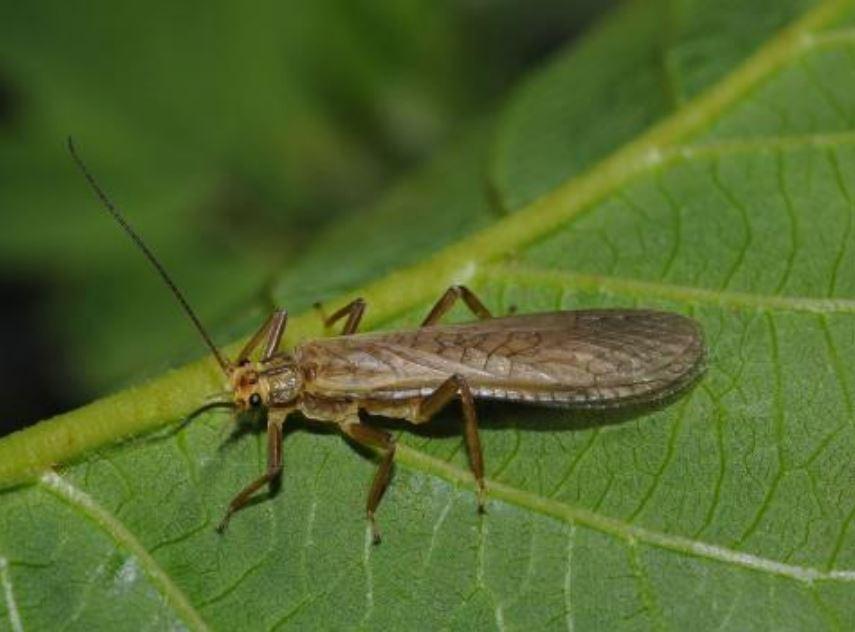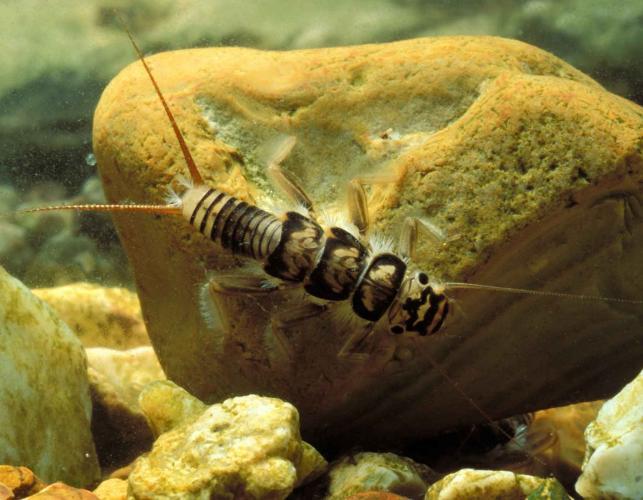The population size of Yosemite springfly is low in Washington and the trend is unknown. They are in the Plecoptera order of insects, commonly known as stoneflies. Stoneflies generally require cold, clear, running water and are especially sensitive to human disturbance; they are excellent indicators of water quality. An estimated 43 percent of North American stoneflies are vulnerable to extinction, imperiled, or extinct.
Description and Range
Physical description
Adult stoneflies have two sets of clear, fine-veined wings that lay close to the body. These insects have long, thin antennae. The larvae (nymphs) look like wingless adults, but often have external gills, which may be present on almost any part of the body. Depending on the species, stonefly nymphs range in size from ½ to 1 ½ inches in length not counting appendages.
Ecology and life history
The Yosemite springfly is reported from glacier-fed streams. Stoneflies usually live in areas with running water, and are important predators and shredders in aquatic ecosystems. Adults are terrestrial and can be found near aquatic habitats with running water, resting on rocks, debris, and vegetation. As nymphs, stoneflies live in aquatic habitats, mainly along the bottom of cool, clean, flowing waters with relatively high oxygen concentrations, mainly on rocky, stony, or gravel substrates.
The females lay hundreds or even thousands of eggs in a ball which they initially carry on their abdomens, and later deposit into the water. The eggs typically hatch in two to three weeks, but some species undergo diapause as eggs during the dry season. The nymphs physically resemble wingless adults, but often have external gills, which may be present on almost any part of the body. The nymphs (technically, "naiads") are aquatic and live in the benthic zone of well-oxygenated creeks and lakes.
In early stages (called instars), stoneflies tend to be herbivores or detritivores, feeding on plant material such as algae, leaves, and other fresh or decaying vegetation; in later instars, the nymphs of many species shift to being omnivores or carnivores, and some species become predators on other aquatic invertebrates.
The insects remain in the nymphal form for one to four years, depending on species, and undergo from 12 to 33 molts before emerging and becoming terrestrial as adults.
Stonefly adults are generally weak fliers and stay close to stream, river, or lake margins where the nymphs are likely to be found. The adults emerge only during specific times of the year and only survive one to four weeks.
As adults, very few stonefly species feed but those that do, feed on algae and lichens, nectar, or pollen.
Geographic range
The Yosemite springfly is known from Mount Rainier National Park (Fryingpan Creek at Sunrise Road Bridge, Pierce County), Mount Baker Wilderness (Mount Baker-Snoqualmie National Forest in Whatcom County), Mount Hood, Oregon, and Mount Lyell, (Yosemite National Park) California.
Climate vulnerability
Sensitivity to climate change
High
The Yosemite springfly is rare, found only in high-elevation glacier-fed streams within Washington, Oregon, and California. Little else is known about this species, but sensitivity probably is tied to specialized habitat requirements, which will be affected by melting glaciers and an associated rise in stream temperatures. Like all other stoneflies, changes in flow patterns due to drought or changing patterns of precipitation and decreased water quality are also likely to increase the sensitivity of the species, as well as habitat fragmentation and nearby development which may alter the quality and availability of suitable habitat.
Exposure to climate change
Moderate-
High
- Increased water temperatures
- Reduced glacier size and increased glacier melting
- Changes in precipitation and/or drought
- Altered flow regimes
Conservation
Conservation Threats and Actions Needed
- Resource information collection needs
- Threat: Lack of data on current status and distribution.
- Action Needed: Determine distribution and population status.
See the Climate vulnerability section for information about the threats posed by climate change to this species.
Resources
References
Fallon, C., and E. Blevins. 2020. Alpine stonefly surveys in Washington State: an assessment of the status and distribution of the Northern Forestfly, Lednia borealis. Final report to the Northwest Ecological Research Institute for survey years 2018 and 2019. The Xerces Society, Portland, Oregon. 51 pp.
Kondratieff, B. C. and R. A. Lechleitner. 2002. Stoneflies (Plecoptera) of Mt. Rainer National Park, Washington. Western North American Naturalist 62(4): 385–404.
NatureServe. 2014. NatureServe Explorer: An online encyclopedia of life [web application]. Version 7.1. NatureServe, Arlington, Virginia. Available http://explorer.natureserve.org. (Accessed: September 22, 2014 ).

